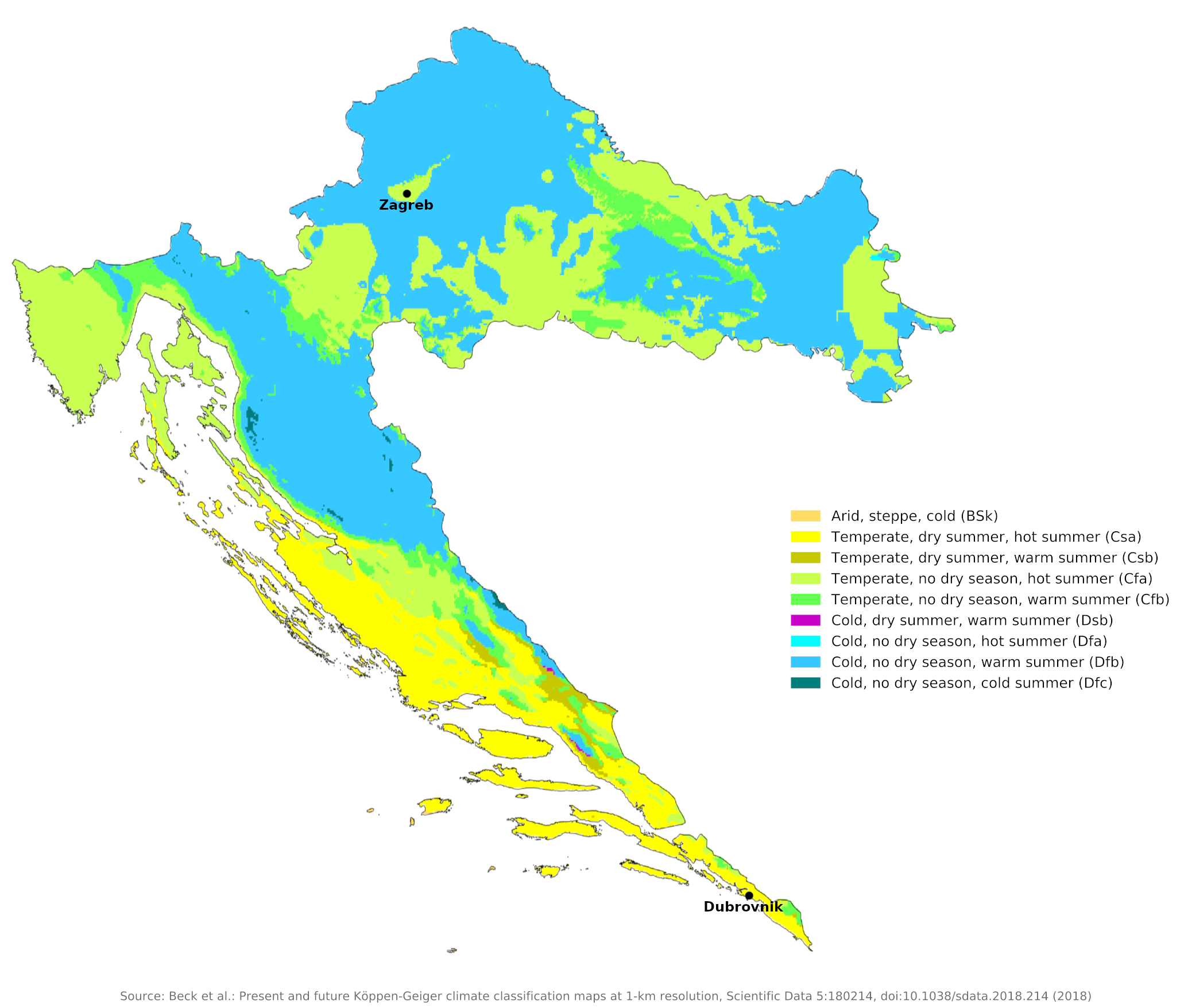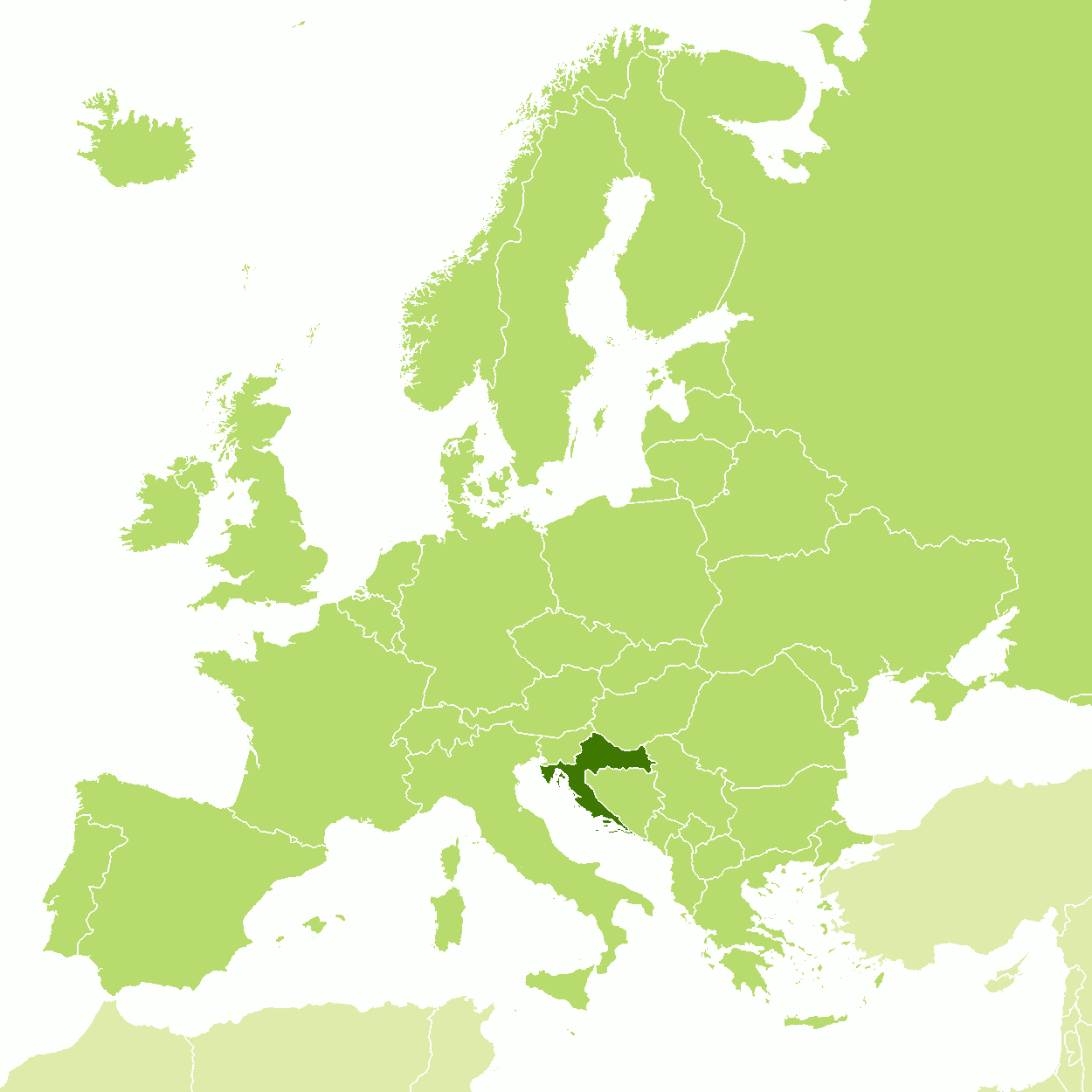The Climate of
Croatia
.jpg) View over Dubrovnik
View over Dubrovnik
Climate Map
 Climate map of the Croatia
Climate map of the Croatia
What is the climate of Croatia like?
Croatia is located in southeastern Europe with a coastline on the Adriatic Sea. It shares borders with Slovenia on the west, Hungary on the north, Serbia on the east, and Bosnia and Herzegovina on the south.
The climate in Croatia is predominantly temperate. The Adriatic coast, which has a Mediterranean climate is backed by the high mountains of the Dinaric Alps, rising to between 1,200 and 1,800 meters (4,000–6,000 feet). Much of western Croatia is mountainous or hilly, whereas eastern Croatia includes much low-lying land in the valleys of the Danube, Drave, and Save.
Coastal Croatia
The Adriatic coast has a moderate, Mediterranean climate with mild winters and warm, sunny summers with turquoise blue skies. The average annual temperatures for the coastal cities of Split and Dubrovnik is 16°C (61°F). The prevailing northeast winds include the maestral (not to be confused with the 'mistral'), which mitigates the heat in the summer, cooling the land during mornings and afternoons.
Winters are cool and rainy. The bora is an unpleasant feature of the winter weather. It is a cold gusty wind which brings cold air from central and eastern Europe down to the coast for a few days at a time; it blows particularly violently in the north of the Adriatic, sweeping down through gaps in the coastal mountains. A southwest wind, the jugo, brings winter rains.
Summers on this coast are not entirely rainless, and the fine, sunny weather is often interrupted by thunderstorms. Sunshine averages some four hours a day in winter and from ten to twelve hours a day in summer. Dubrovnik is characteristic of weather on the Dalmatian coast of Croatia.
| Climate data for Dubrovnik (1971–2000) | |||||||||||||
|---|---|---|---|---|---|---|---|---|---|---|---|---|---|
| Month | Jan | Feb | Mar | Apr | May | Jun | Jul | Aug | Sep | Oct | Nov | Dec | Year |
| Average high °C (°F) | 12.3 (54.1) | 12.6 (54.7) | 14.4 (57.9) | 16.9 (62.4) | 21.5 (70.7) | 25.3 (77.5) | 28.2 (82.8) | 28.5 (83.3) | 25.1 (77.2) | 21.1 (70.0) | 16.6 (61.9) | 13.4 (56.1) | 19.7 (67.5) |
| Daily mean °C (°F) | 9.2 (48.6) | 9.4 (48.9) | 11.1 (52.0) | 13.8 (56.8) | 18.3 (64.9) | 22.0 (71.6) | 24.6 (76.3) | 24.8 (76.6) | 21.4 (70.5) | 17.6 (63.7) | 13.3 (55.9) | 10.3 (50.5) | 16.3 (61.3) |
| Average low °C (°F) | 6.6 (43.9) | 6.8 (44.2) | 8.4 (47.1) | 11.0 (51.8) | 15.3 (59.5) | 18.9 (66.0) | 21.4 (70.5) | 21.6 (70.9) | 18.4 (65.1) | 14.9 (58.8) | 10.7 (51.3) | 7.8 (46.0) | 13.5 (56.3) |
| Average precipitation mm (inches) | 98.3 (3.87) | 97.9 (3.85) | 93.1 (3.67) | 91.4 (3.60) | 70.1 (2.76) | 44.0 (1.73) | 28.3 (1.11) | 72.5 (2.85) | 86.1 (3.39) | 120.1 (4.73) | 142.3 (5.60) | 119.8 (4.72) | 1,064 (41.89) |
| Source: Croatian Meteorological and Hydrological Service | |||||||||||||
Inland Croatia
Inland climatic conditions rapidly become more typical of eastern Europe with cold winters and warm, humid summers—summer here is the wettest season. Winter snow lies for long periods in the higher regions. In Eastern Croatia, winters are rather cold and rainfall lower. A dry wind, the košava, brings freezing air from central Eurasia in the winter, but snowfall is usually light. In Zagreb, the average daily high temperature in July is 27°C (80°F), while in January it falls to 4°C (38°F). The overall average annual temperature in Zagreb is 11°C (51°F).
| Climate data for Zagreb (1971–2000) | |||||||||||||
|---|---|---|---|---|---|---|---|---|---|---|---|---|---|
| Month | Jan | Feb | Mar | Apr | May | Jun | Jul | Aug | Sep | Oct | Nov | Dec | Year |
| Average high °C (°F) | 3.7 (38.7) | 6.8 (44.2) | 11.9 (53.4) | 16.3 (61.3) | 21.5 (70.7) | 24.5 (76.1) | 26.7 (80.1) | 26.3 (79.3) | 22.1 (71.8) | 15.8 (60.4) | 8.9 (48.0) | 4.6 (40.3) | 15.8 (60.4) |
| Daily mean °C (°F) | 0.3 (32.5) | 2.3 (36.1) | 6.4 (43.5) | 10.7 (51.3) | 15.8 (60.4) | 18.8 (65.8) | 20.6 (69.1) | 20.1 (68.2) | 15.9 (60.6) | 10.5 (50.9) | 5.0 (41.0) | 1.4 (34.5) | 10.7 (51.3) |
| Average low °C (°F) | −3.0 (26.6) | −1.8 (28.8) | 1.6 (34.9) | 5.2 (41.4) | 9.8 (49.6) | 13.0 (55.4) | 14.7 (58.5) | 14.4 (57.9) | 10.8 (51.4) | 6.2 (43.2) | 1.4 (34.5) | −1.7 (28.9) | 5.9 (42.6) |
| Average precipitation mm (inches) | 43.2 (1.70) | 38.9 (1.53) | 52.6 (2.07) | 59.3 (2.33) | 72.6 (2.86) | 95.3 (3.75) | 77.4 (3.05) | 92.3 (3.63) | 85.8 (3.38) | 82.9 (3.26) | 80.1 (3.15) | 59.6 (2.35) | 840.1 (33.07) |
| Source: Croatian Meteorological and Hydrological Service | |||||||||||||
When is the best time to visit Croatia?
Croatia is warm along the coast, cooler in the interior. April–October is best for sunshine, December–April for winter sports.
References
- E. A. Pearce, Charles Gordon Smith, (1990) The Hutchinson World Weather Guide, John Murray Press. ISBN 1859863426
- Timothy L. Gall, (ed.), (2003), Worldmark Encyclopedia of the Nations, Eleventh Edition, Thomson Gale
- Federal Research Division, Library of Congress, (1992), Yugoslavia: a country study. Claitor's Pub. Division. ISBN 0844407356
- Hugh Chisholm, (ed.), (1911), Encyclopædia Britannica, Eleventh edition, Cambridge University Press
The Climate of
Croatia

In summary:
The climate in Croatia is mostly a moderate one. Along the coast, the climate is Mediterranean with mild winters and dry summers. In the mountains, summers are cool and winters cold and snowy. Croatia’s climate in the eastern lowlands features hot, dry summers and cold winters. In Zagreb, the average annual temperature is 11°C (51°F) with average highs of 4°C (39°F) in January and 27°C (80°F) in July. Annual average precipitation is about 940 mm (37 in).